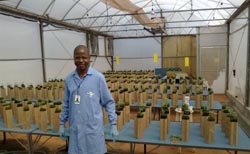In August 2012 Amaral Chibeba started his PhD research in Mozambique under the supervision of Dr. Mariangela Hungria (Embrapa), Dr. Maria de Fátima Guimarães (Universidade Estatual de Londrina) and Dr. Stephen Boahen (International Institute of Tropical Agriculture)
We enjoy sharing the summary of his study.
| The characterization of indigenous Bradyrhizobium populations is essential for developing strategies to improve soyabean nodulation. TGx genotypes are among the most promotes soyabean varieties in Mozambique. For the characterization of the indigenous Bradyrhizobium, soyabean nodules of TGx genotypes were sampled at 15 locations in Mozambique. A total of 105 isolates were obtained, 7 from each location, and are being screened for symbiotic efficiency in the greenhouse at Embrapa. The trial was sown on 03rd December and thinning was done on 11 December 2013 (Figure 1). From this trial, the best performing isolates will be tested in the field in two cropping seasons, 2014/15 and 2015/16. Simultaneously, trials with elite soyabean Bradyrhizobium strains will be conducted in both Brazil and Mozambique to evaluate their performance, and co-inoculation with Azospirillum will be studied both under greenhouse and field conditions. Based on the results of the field trials, the best strategies will be recommended for soyabean production in Mozambique. |

Figure 1: Amaral Chibeba during thinning on 11 December 2013
|
Bradyrhizobium spp. have been used in commercial inoculants for effective nodulation of soyabean (Glycine max (L.) Merr) in the main producing countries where this crop is exotic. Currently used commercial strains are classified in three species of the genus Bradyrhizobium: B. japonicum, B. elkanii and B. diazoefficiens. To reduce the dependence of inoculation of soyabean with Bradyhrizobium, researchers at the International Institute of Tropical Agriculture developed a line of genotypes for Africa known as TGx (Tropical Glicyne cross), which nodulates with populations of Bradyrhizobium spp. indigenous to African soils. However, in some locations, TGx genotypes have shown symptoms of nitrogen deficiency, which suggests that, for these locations, genotypes require inoculation with selected Bradyrhizobium for obtaining high yields.
